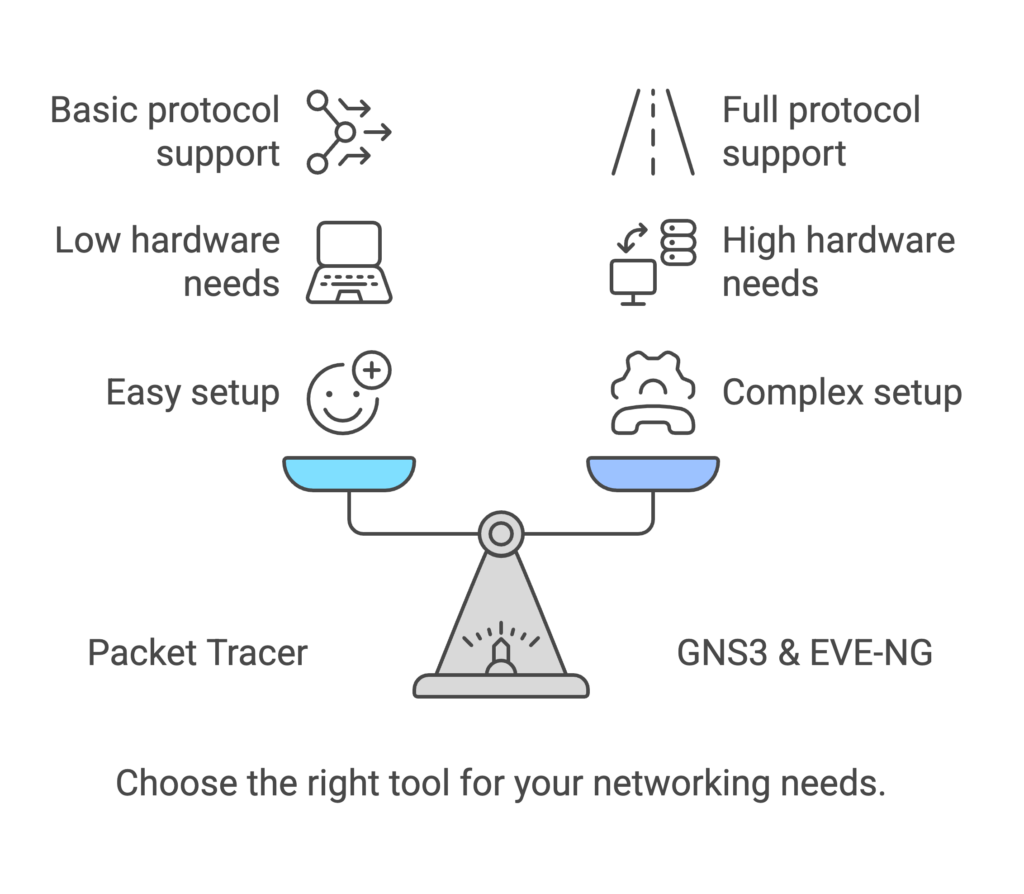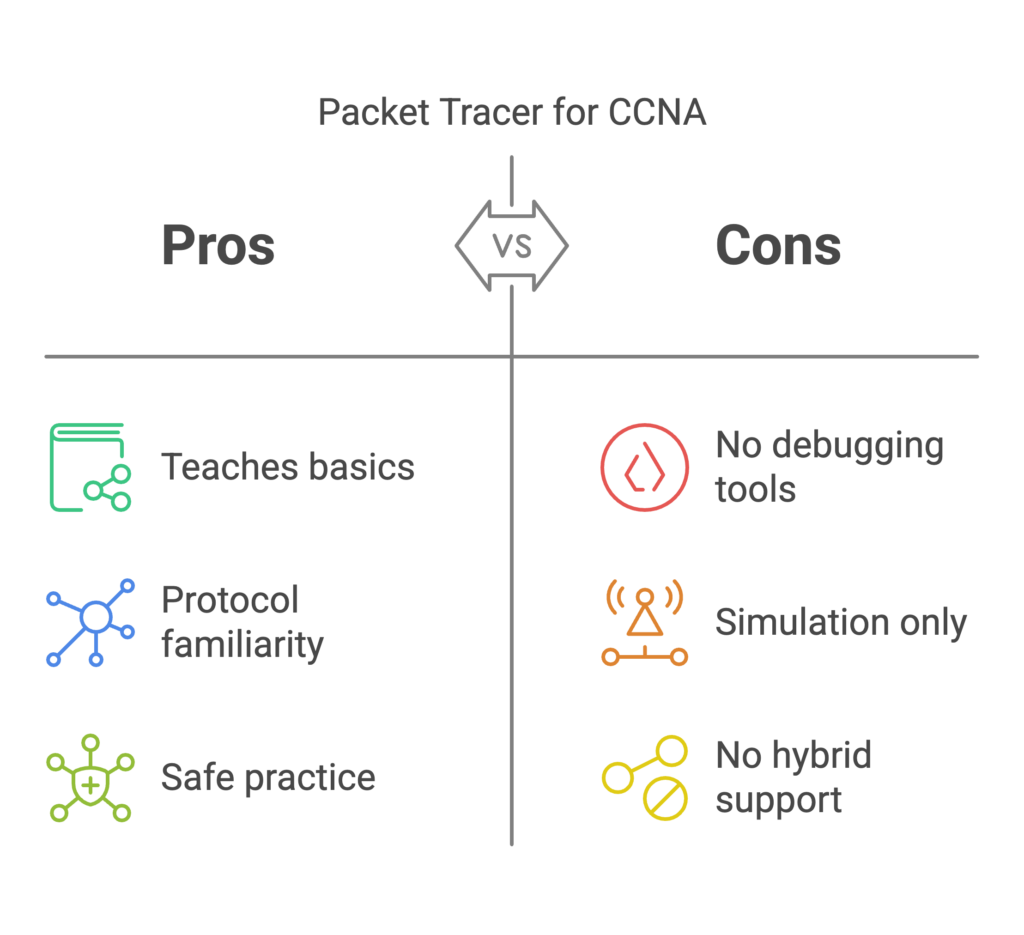Table of contents
- What Is Packet Tracer?
- Why This Tool Is Popular Among Students
- The Limitations of Packet Tracer
- Packet Tracer vs. GNS3 vs. EVE-NG: Which One Should You Use?
- Which One Should You Use?
- Is Packet Tracer Good Enough for CCNA?
- Best Practices for Using Packet Tracer
- Final Recommendation
- Enhance Your Learning with Additional Resources
- Frequently Asked Questions
Have you ever wondered if Cisco Packet Tracer can truly prepare you for the CCNA exam or even real-world networking jobs? It’s a tool every networking student has likely heard of or used while studying. But here’s the big question: does it equip you with practical, hands-on skills, or is it just a beginner’s stepping stone?
Let’s break it down to see what this Cisco tool can and can’t do so you can decide how to use it effectively in your learning journey.
What Is Packet Tracer?
Cisco Packet Tracer is a virtual lab environment that acts as a sandbox for networking concepts. It allows you to build and test network topologies without needing physical hardware.
Here’s why it’s valuable:
- Create simple to complex network designs.
- Test protocols like OSPF, VLANs, and ACLs.
- Practice troubleshooting without risking real-world equipment.
- Gain hands-on exposure in a safe, controlled environment—perfect for beginners.
It’s like training wheels for aspiring network engineers.
Why This Tool Is Popular Among Students
Packet Tracer has become a go-to tool for networking students worldwide, and here’s why:
- Super Beginner-Friendly:
Its intuitive interface and straightforward design make it easy for anyone to get started, even with no prior networking experience. - Cost-Effective:
You don’t need to buy expensive routers and switches. This simulator provides an affordable way to practice networking concepts. - Flexible Learning:
From basic LAN setups to advanced routing protocols, the tool supports a wide range of scenarios, making it adaptable to various skill levels. - Certification-Oriented
Most Packet Tracer labs align with CCNA exam objectives, providing focused practice for certification candidates. - Safe for Experimentation
Mistakes won’t damage actual hardware. You can reset and try again, fostering a stress-free learning environment.
The Limitations of Packet Tracer
While Packet Tracer is undeniably useful, it’s not without flaws. Let’s explore some of its limitations:
- No Hands-On Hardware Experience:
Real-world networking involves working with physical routers, switches, and cables. Packet Tracer doesn’t replicate that hands-on aspect, which is crucial for field jobs. - Limited Protocol Support:
The tool covers foundational protocols like OSPF and VLANs, but advanced configurations like Ospf or eigrp are either missing or simplified. - Not Suitable for Large-Scale Networks:
It struggles to simulate complex, enterprise-level networks effectively. - Simplified Troubleshooting:
The troubleshooting environment lacks the unpredictability and complexity of real networks. Physical issues like faulty cables or power problems are absent. - Cisco-Centric:
It’s tailored to Cisco environments, which limits exposure to non-Cisco devices and setups.
Packet Tracer vs. GNS3 vs. EVE-NG: Which One Should You Use?

Now that we’ve covered the limitations of Packet Tracer, you might be wondering:
“If Packet Tracer isn’t perfect, what are my other options?”
Great question! Let’s compare Packet Tracer, GNS3, and EVE-NG—the three most popular tools for network simulations and labbing.
Packet Tracer is a simulator, meaning it mimics how Cisco devices behave, but doesn’t run real IOS. In contrast, GNS3 and EVE-NG are emulators, allowing you to run actual Cisco IOS images for a more realistic experience.
Here’s a side-by-side comparison to help you decide which tool fits your needs:
| Feature | Packet Tracer (Simulation) | GNS3 (Emulation) | EVE-NG (Emulation) |
|---|---|---|---|
| Type | Simulator (Not real Cisco IOS) | Emulator (Uses real Cisco IOS) | Emulator (Uses real Cisco IOS) |
| Ease of Setup | ✅ Super easy | ❌ Takes time to configure | ⚠️ Moderate (Easier with CCNA Full Pack) |
| Hardware Requirements | ✅ Low (Runs on any PC) | ❌ Requires powerful PC | ❌ Best with dedicated server |
| CCNA Suitability | ✅ Great for beginners | ✅ Good for advanced users | ✅ Great for CCNA (Beginners with CCNA Full Pack) |
| CCNP/CCIE Suitability | ❌ Limited | ✅ Recommended | ✅ Best option |
| Protocol Support | ⚠️ Basic (Supports OSPF & EIGRP, No BGP, MPLS, or advanced STP) | ✅ Full Cisco IOS support | ✅ Full Cisco IOS support |
| Switching Support | ⚠️ Limited (No real Layer 3 switching) | ✅ Supports real switching | ✅ Supports real switching |
| Packet Analysis | ❌ No Wireshark support | ✅ Works with Wireshark | ✅ Works with Wireshark |
| Real-World Simulation | ❌ Simplified (Some bugs) | ✅ More realistic | ✅ Closest to real-world |
| Integration with Physical Devices | ❌ Not possible | ✅ Yes | ✅ Yes |
| Multi-Vendor Support | ❌ Cisco only | ✅ Supports Juniper, Palo Alto, etc. | ✅ Supports Juniper, Palo Alto, etc. |
| Best For | CCNA beginners | Intermediate to advanced users | Beginner & Advanced Users (Best with CCNA Full Pack) |
Which One Should You Use?
So, which tool is best for CCNA preparation? It depends on your learning style and goals.
- If you’re just starting out and want a quick and easy way to practice, Packet Tracer is the best option.
- If you want more realism, GNS3 is great, but it takes time to set up.
- If you’re looking for a complete hands-on experience with real Cisco images, EVE-NG is a fantastic choice—even for CCNA!
Want a fully structured CCNA learning experience?
Check out the CCNA Full Pack, designed for EVE-NG users, with pre-built labs, workbooks, and expert guidance.
With EVE-NG and CCNA Full Pack, you don’t just simulate networking—you practice real-world scenarios just like in a real network environment!
Is Packet Tracer Good Enough for CCNA?
Now, let’s address the primary question: is Packet Tracer sufficient for CCNA preparation? The answer is both yes and no.
Why yes?
- Teaches the Basics: You’ll learn foundational skills like IP addressing, VLAN configurations, and basic routing protocols.
- Protocol Familiarity: It helps you understand OSPF, STP, and ACLs, building a strong theoretical base.
- Safe Practice: You can explore configurations in a risk-free, virtual environment.
Why no?
- No Debugging Tools: Advanced diagnostic tools like Wireshark or real Cisco debug commands aren’t available, limiting troubleshooting practice.
- Simulation, Not Emulation: Unlike tools like GNS3 or EVE-NG, Packet Tracer models network behavior but doesn’t replicate real-world conditions accurately.
- Lack of Hybrid Support: You can’t integrate physical hardware, which is essential for real-world scenarios.

Best Practices for Using Packet Tracer
Want to make the most of this tool? Here’s how:
- Start Small:
Begin with basic setups like single LANs or point-to-point connections. Master the fundamentals before moving to advanced scenarios. - Use Certification Labs:
Follow pre-designed labs that align with CCNA objectives. These structured activities focus on exam-relevant skills. - Experiment Freely:
Don’t shy away from making mistakes. Break your configurations intentionally and learn how to troubleshoot them—it’s an excellent way to build problem-solving skills. - Combine with Theory:
Pair Packet Tracer exercises with theoretical study. Understanding the “why” behind each configuration reinforces learning. - Step Up Gradually:
As you gain confidence, tackle advanced topics like VLAN trunking, inter-VLAN routing, and dynamic routing protocols. - Review and Repeat:
Repetition builds confidence. Practice the same labs multiple times until you can complete them seamlessly.
Final Recommendation
Cisco Packet Tracer is an excellent starting point for networking students, particularly those preparing for CCNA. It teaches foundational skills, provides hands-on practice, and aligns with certification objectives. However, it’s not a complete substitute for real hardware or advanced simulators like GNS3 and EVE-NG.
To become a well-rounded network engineer, use Packet Tracer as a stepping stone. Then, gradually incorporate more advanced tools and real-world practice into your learning journey.
What’s your experience with Packet Tracer? Share your thoughts in the comments below, or explore one of our free labs to see how this tool can enhance your skills!
Enhance Your Learning with Additional Resources
To complete this discussion and provide even more value to networking enthusiasts, let’s explore some other tools and resources that are incredibly useful for mastering networking concepts:
CCNA Full Pack
If you’re serious about passing the CCNA exam, the CCNA Full Pack is a game-changer. This comprehensive package includes:
- Study Timeline: A structured timeline breaking chapters into focused sections, helping you study effectively step-by-step.
- Cheat Sheets: Quick-reference guides to key CCNA concepts.
- Summary: Concise chapter summaries for faster revision.
- Hands-On Labs (Workbook): Detailed workbooks that guide you through each lab.
- Lab Files: Pre-configured files to save you setup time.
- Quiz: Test your knowledge and track your progress.
- Video Tutorials: Step-by-step videos demonstrating how to execute each lab, perfect for beginners who want clear, guided instructions.
- Support: Access to our expert team whenever you need help.
- Bonus: CCNA Command Jumpstart: Master essential commands with ease.
Explore this resource here: Discover CCNA Full Pack
Other Tools
- EVE-NG Full Pack: Over 220 real-world scenarios and 140 workbooks, ideal for mastering advanced networking.
- GNS3 Full Pack: Preconfigured labs and images for creating and testing complex network topologies.
Frequently Asked Questions
Absolutely! This simulator offers a safe and affordable way to practice configurations, understand protocols, and explore networking concepts. For beginners, it’s an invaluable resource.
Yes, it covers most foundational topics required for the CCNA exam. However, for advanced concepts like BGP or MPLS, tools like GNS3 or EVE-NG are recommended.
Definitely! Cisco Packet Tracer is a simulation tool that allows users to design, configure, and troubleshoot networks in a virtual environment.
Yes, it’s widely used in educational settings and by Cisco Networking Academy to teach networking concepts and prepare students for certifications.
You can download it from the Cisco Networking Academy website. A free account is required to access the software and additional resources.